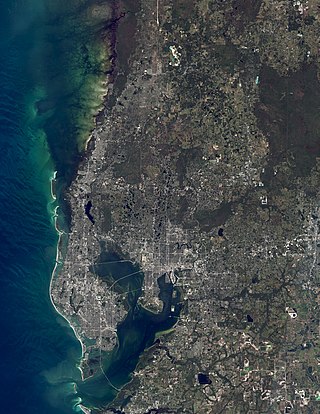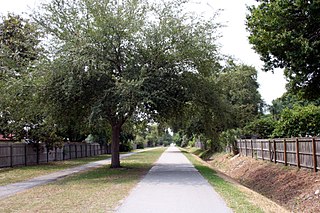
Pinellas County is a county located on the west central coast of the U.S. state of Florida. As of the 2020 census, the population was 959,107, making it the seventh-most populous county in the state. It is also the most densely populated county in Florida, with 3,491 residents per square mile. The county is part of the Tampa–St. Petersburg–Clearwater Metropolitan Statistical Area. Clearwater is the county seat. St. Petersburg is the largest city in the county, as well as the largest city in Florida that is not a county seat.

St. Petersburg is a city in Pinellas County, Florida, United States. As of the 2020 census, the population was 258,308, making it the fifth-most populous city in Florida and the most populous city in the state that is not a county seat. It is the second-most populous city in the Tampa Bay area, which is the second-largest metropolitan area in Florida with an estimated population of about 3.29 million in 2022.

Clearwater is a city and the county seat of Pinellas County, Florida, United States, west of Tampa and north of St. Petersburg. To the west of Clearwater lies the Gulf of Mexico and to the southeast lies Tampa Bay. As of the 2020 census, the city had a population of 117,292. It is the smallest of the three principal cities in the Tampa–St. Petersburg–Clearwater metropolitan area, most commonly referred to as the Tampa Bay area.

Dunedin is a city in Pinellas County, Florida, United States. The name comes from Dùn Èideann, the Scottish Gaelic name for Edinburgh, the capital of Scotland. Dunedin is part of the Tampa–St. Petersburg–Clearwater metropolitan area and is the fifth largest city in Pinellas County. The population was 36,068 as of the 2020 census.

Oldsmar is a city in Pinellas County, Florida, United States. As of the 2020 census, the city had a population of 14,898. The Oldsmar name dates to April 12, 1916, when automobile pioneer Ransom E. Olds purchased 37,541 acres (151.92 km2) of land north of Tampa Bay to establish a planned community.

Pinellas Park is a city located in central Pinellas County, United States. The population was 53,093 at the 2020 census. The city is the fourth largest city in Pinellas County. The City of Pinellas Park was incorporated in 1914. It is part of the Tampa–St. Petersburg–Clearwater Metropolitan Statistical Area, most commonly referred to as the Tampa Bay Area.

Tarpon Springs is a city in Pinellas County, Florida, United States. Downtown Tarpon Springs has long been a focal point and underwent beautification in 2010. It is part of the Tampa Bay area. The population was 25,117 at the 2020 census.

The Tampa Bay area is a major metropolitan area surrounding Tampa Bay on the Gulf Coast of Florida in the United States. It includes the main cities of Tampa, St. Petersburg, and Clearwater. It is the 17th-largest metropolitan area in the United States, with a population of 3,175,275 as of the 2020 U.S. Census.

Timeline of Pinellas County, Florida history.

The Fred Marquis Pinellas Trail is a rail trail in Pinellas County, Florida. It stretches from Tarpon Springs in the north to St. Petersburg in the south, passing through the towns of Palm Harbor, Dunedin, Belleair, Clearwater, Largo, Seminole, South Pasadena, and Gulfport. It is utilized for walking, jogging, and cycling. Some trail users are able to commute to work using the Pinellas Trail instead of a motor vehicle.

The Bradenton Marauders are a Minor League Baseball team of the Florida State League and the Single-A affiliate of the Pittsburgh Pirates. They are located in Bradenton, Florida, and play their home games at LECOM Park, which also serves as the Pirates' spring training facility.

The St. Petersburg Museum of History (SPMOH) is a history museum located in St. Petersburg, Florida, dedicated to covering the area's history. As of 2020, the museum's director is Rui Farias.

St. Petersburg station was a passenger train station in St. Petersburg, Florida. Located northwest of downtown, its former address was 3601 31st Street North, though access to the site is now only from 37th Avenue North.

Tampa Bay History Center is a history museum in Tampa, Florida, United States. It is a Smithsonian Affiliate and has been accredited by the American Alliance of Museums since 2015. Exhibits include coverage of the Tampa Bay area's first native inhabitants, Spanish conquistadors, and historical figures who shaped the area's history, as well as a reproduction of a 1920s cigar store. The museum is on the waterfront at 801 Water Street in Tampa's Channelside District. It opened on January 17, 2009. The History Center building is 60,000 square feet (5,600 m2) with 25,000 square feet (2,300 m2) of exhibit space.
The Orange Belt Railway was a 3 ft narrow gauge railroad established in 1885 by Russian exile Peter Demens in Florida. It was one of the longest narrow gauge railroads in the United States at the time of its completion in 1888, with a mainline 152 miles (245 km) in length between Sanford and St. Petersburg. It carried citrus, vegetables, and passengers; and it interchanged with two standard gauge lines: the Jacksonville, Tampa and Key West Railway at Lake Monroe, and the Florida Central and Peninsular Railroad at Lacoochee.

The Tarpon Springs Depot is a former railroad depot built by the Atlantic Coast Line Railroad in 1909, located in downtown Tarpon Springs, Florida at 160 East Tarpon Avenue within the Tarpon Springs Historic District.

The Bay Pines Veterans Administration Home and Hospital Historic District is a U.S. historic district located at 10000 Bay Pines Blvd. in Bay Pines, Florida. The district contains prehistoric aboriginal sites and fourteen Mediterranean Revival style hospital buildings constructed from the 1930s. The district is home to the Bay Pines Veterans Affairs Medical Center, a general medical and surgical hospital with 396 beds. It is accredited by the Commission on Accreditation of Rehabilitation Facilities (CARF).

The Clearwater Subdivision is a railroad line owned by CSX Transportation in the Tampa Bay region of Florida. The line begins just east of downtown Tampa in Gary and heads north through some of Tampa's suburban neighborhoods. In Sulphur Springs, the Clearwater Subdivision turns and runs west through Oldsmar, where it crosses Tampa Bay. It briefly shifts south running through Safety Harbor, and then heads west again to Clearwater. In Clearwater, it turns southeast, running through Largo and Pinellas Park before terminating at Fifth Avenue North in St. Petersburg near Tropicana Field. The distance from Gary to St. Petersburg along the line is 48.6 miles (78.2 km). At the line's north end it continues from the Tampa Terminal Subdivision and at its south end the track comes to an end.
The Tampa and Gulf Coast Railroad (T&G) was a railroad company in the Tampa Bay Area of Florida in the United States. It initially built and operated a line that ran from the Tampa Northern Railroad main line in Lutz west to Tarpon Springs and into Pasco County. Additional track starting from Sulphur Springs running west towards Clearwater and south to St. Petersburg was built shortly after. The railroad was informally known as the "Tug n' Grunt" and the "Pea Vine" due to its frequent twists and turns. While it was the second railroad to serve St. Petersburg and Clearwater after the Orange Belt Railway, it had the advantage of being the first to connect the area directly with Tampa.
Pinellas High School was a public high school from 1934 until 1968 in Clearwater, Florida. It served African Americans from the surrounding area of northern Pinellas County including Largo, Clearwater, Dunedin, Safety Harbor and Tarpon Springs during the era of segregation. It was at 1220 Palmetto Street. During its existence, it was the first segregated school in the region and it was the only school exclusively serving Black students in Pinellas County.

















